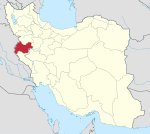Sonqor
 From Wikipedia - Reading time: 10 min
From Wikipedia - Reading time: 10 min
Sonqor
Persian: سنقر | |
|---|---|
City | |
| Coordinates: 34°46′58″N 47°35′54″E / 34.78278°N 47.59833°E[1] | |
| Country | Iran |
| Province | Kermanshah |
| County | Sonqor |
| District | Central |
| Population (2016)[2] | |
• Total | 44,256 |
| Time zone | UTC+3:30 (IRST) |
Sonqor (Persian: سنقر)[a] is a city in the Central District of Sonqor County, Kermanshah province, Iran, serving as capital of both the county and the district.[4] It is in the Zagros Mountains, about 90 kilometers from the province's capital city Kermanshah, and consists of two valleys; that of Gavehrud and Shajarud.[5][6] Sonqor lies between the modern cities of Kangavar and Sanandaj.[6]
Demographics
[edit]Population
[edit]At the time of the 2006 National Census, the city's population was 43,184 in 11,377 households.[7] The following census in 2011 counted 44,954 people in 13,228 households.[8] The 2016 census measured the population of the city as 44,256 people in 13,996 households.[2]
Etymology
[edit]The name Sonqor may derive from the Turkic chief Sonqor, a vassal of the Mongols of Shiraz, Fars, who had arrived in the region with his men during the Mongol occupation of Iran.[6]
Geography and history
[edit]In medieval Iran, Sonqor was situated on the road that ran between Dinavar and Adharbaydjan.[6] The orientalist Vladimir Minorsky (died 1966) argued that Sonqor must have therefore corresponded approximately to the first marḥala on the stretch from Dinavar to Sisar, the name of which is recorded as al-Djarba by Al-Maqdisi (died 991) and as Kharbadjan by Ibn Khordadbeh (fl. 9th century), and was 7 farsakhs from Dinavar.[6] The present-day distance between the ruins of Dinavar and Sonqor however, is not more than 24 kilometers.[6] Based on these arguments, Sonqor might have therefore corresponded to the medieval district of Maybahradj as noted by Al-Baladhuri (died 892), which was separated from Dinavar under Abbasid Caliph Al-Mahdi (r. 775–785) and joined to Sisar.[6]
Sonqor is separated from Dinavar through the pass of Mele-mas on the "line of heights" that stretches from Dalakham to Amrula.[6] To its northeast, the city of Sonqor is bordered by mount Pandjeh Ali; behind this mountain runs the road from Hamadan to Sanandaj.[6] The upper tributaries of the river that runs to Dinavar also flows into Sonqor, and which ultimately joins the Gamasab river.[6] The second edition of the Encyclopaedia of Islam notes that Sonqor, in the "strict sense", is neighboured by the (more northern) district of Kulya'i "on the upper course" of the Gawarud.[6] The western dependencies of the Gawarud in turn are Bilawar and Niyabat.[6] Sonqor was important in history for being located on the road followed by Muslim pilgrims who moved from Tabriz to Kermanshah.[6] This route avoided the predominantly Kurdish territory of Sanandaj and followed a detour through Bijar (Garrus) and Sonqor, eventually reaching Kermanshah within a day's march.[6]
Sights
[edit]The Ilkhanate era Malek Tomb is located in the city.
Demographics
[edit]Sonqor County, in which the city of Sonqor is located, is made up of two distinct population elements.[6] The city of Sonqor is predominantly inhabited by Turkics, whose ancestors reportedly arrived during the Mongol domination of Iran.[6] The Turkic people of Sonqor originally speak the Sonqori dialect.[9] The area of Sonqor County outside of Sonqor city, on the other hand, is predominantly populated by Kurds most of whom have originally been agriculturalists.[6] The inhabitants of Sonqor city are generally trilingual in Sonqori, Kurdish and Persian.[10]
See also
[edit]Notes
[edit]References
[edit]- ^ OpenStreetMap contributors (13 December 2024). "Sonqor, Sonqor County" (Map). OpenStreetMap (in Persian). Retrieved 13 December 2024.
- ^ a b Census of the Islamic Republic of Iran, 1395 (2016): Kermanshah Province. amar.org.ir (Report) (in Persian). The Statistical Center of Iran. Archived from the original (Excel) on 3 April 2022. Retrieved 19 December 2022.
- ^ Sonqor can be found at GEOnet Names Server, at this link, by opening the Advanced Search box, entering "-3086129" in the "Unique Feature Id" form, and clicking on "Search Database".
- ^ Habibi, Hassan (19 November 2013) [Approved 21 June 1369]. Approval of the organization and chain of citizenship of the elements and units of the national divisions of Bakhtran province, centered in the city of Bakhtran. rc.majlis.ir (Report) (in Persian). Ministry of the Interior, Defense Political Commission of the Government Board. Proposal 3233.1.5.53; Letter 93808/907; Notification 82832/T122K. Archived from the original on 6 February 2013. Retrieved 29 January 2024 – via Research Center of the System of Laws of the Islamic Council of Farabi Mobile Library.
- ^ Nasiri, Ali Naqi; Floor, Willem M. (2008). Titles and Emoluments in Safavid Iran: A Third Manual of Safavid Administration. Mage Publishers. p. 293. ISBN 978-1933823232.
- ^ a b c d e f g h i j k l m n o p q Minorsky 1997.
- ^ Census of the Islamic Republic of Iran, 1385 (2006): Kermanshah Province. amar.org.ir (Report) (in Persian). The Statistical Center of Iran. Archived from the original (Excel) on 20 September 2011. Retrieved 25 September 2022.
- ^ Census of the Islamic Republic of Iran, 1390 (2011): Kermanshah Province. irandataportal.syr.edu (Report) (in Persian). The Statistical Center of Iran. Archived from the original (Excel) on 18 January 2023. Retrieved 19 December 2022 – via Iran Data Portal, Syracuse University.
- ^ Knüppel 2010.
- ^ Borjian 2017, pp. 324–329.
Sources
[edit]- Borjian, Habib (2017). "KERMANSHAH vii. LANGUAGES AND DIALECTS". In Yarshater, Ehsan (ed.). Encyclopædia Iranica. Vol. XVI/3: Kégl–Kešaʾi Dialect. London and New York: Routledge & Kegan Paul. pp. 324–329. ISBN 978-1-934283-50-9.
- Knüppel, Michael (2010) [2000]. "TURKIC LANGUAGES OF PERSIA: AN OVERVIEW". Encyclopædia Iranica.
- Minorsky, V. (1997). "Sunḳur". In Bosworth, C. E.; van Donzel, E.; Heinrichs, W. P. & Lecomte, G. (eds.). The Encyclopaedia of Islam, Second Edition. Volume IX: San–Sze. Leiden: E. J. Brill. ISBN 978-90-04-10422-8.
- Website of CHHTO of Kermanshah
 KSF
KSF
